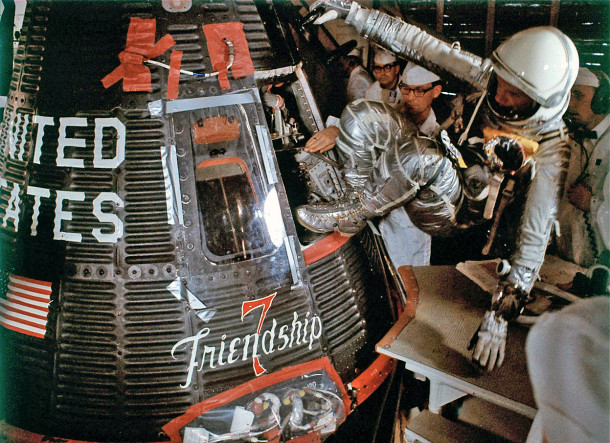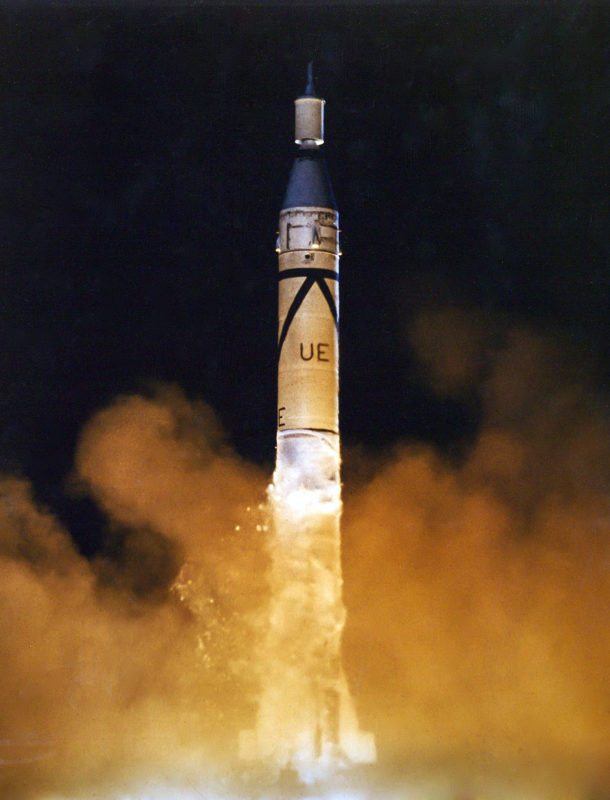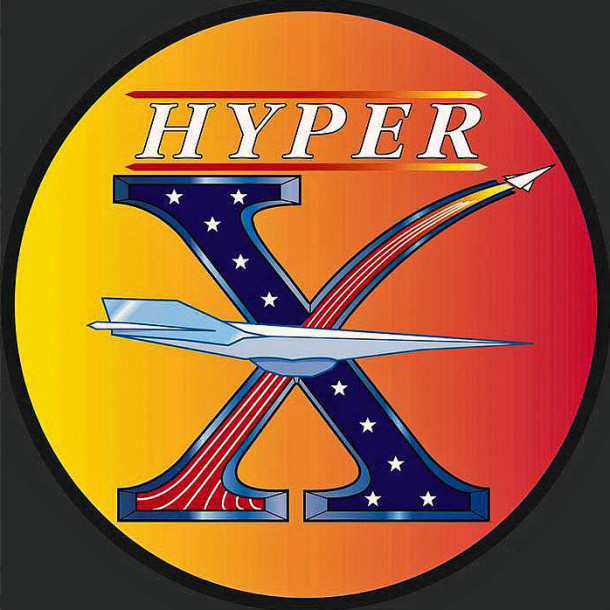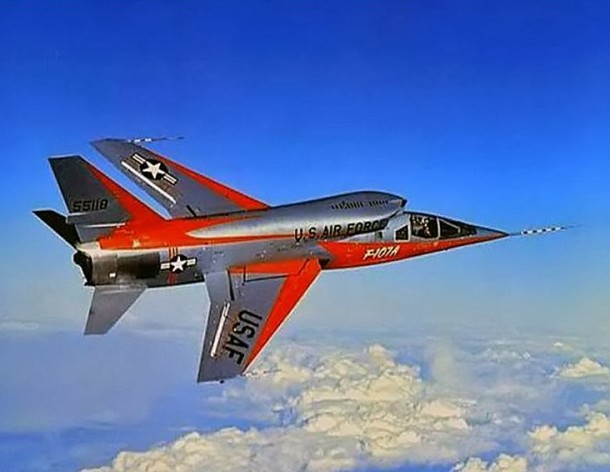
Fifty-nine years ago today, Project Mercury Astronaut John Herschel Glenn, Jr. became the first American to orbit the Earth. Glenn’s spacecraft name and mission call sign was Friendship 7.
Mercury-Atlas 6 (MA-6) lifted-off from Cape Canaveral’s Launch Complex 14 at 14:47:39 UTC on Tuesday, 20 February 1962. It was the first time that the Atlas LV-3B booster was used for a manned spaceflight.
Three-hundred and twenty seconds after lift-off, Friendship 7 achieved an elliptical orbit measuring 143 nautical miles (apogee) by 86 nautical miles (perigee). Orbital inclination and period were 32.5 degrees and 88.5 minutes, respectively.
The most compelling moments in the United States’ first manned orbital mission centered around a sensor indication that Glenn’s heat shield and landing bag had become loose at the beginning of his second orbit. If true, Glenn would be incinerated during entry.
Concern for Glenn’s welfare persisted for the remainder of the flight and a decision was made to retain his retro package following completion of the retro-fire sequence. It was hoped that the 3 flimsy straps holding the retro package would also hold the heat shield in place.
During Glenn’s return to the atmosphere, both the spent retro package and its restraining straps melted in the searing heat of re-entry. Glenn saw chunks of flaming debris passing by his spacecraft window. At one point he radioed, “That’s a real fireball outside”.
Happily, the spacecraft’s heat shield held during entry and the landing bag deployed nominally. There had never really been a problem. The sensor indication was found to be false.
Friendship 7 splashed-down in the Atlantic Ocean at a point 432 nautical miles east of Cape Canaveral at 19:43:02 UTC. John Glenn had orbited the Earth 3 times during a mission which lasted 4 hours, 55 minutes and 23 seconds. In short order, spacecraft and astronaut were successfully recovered aboard the USS Noa.
John Glenn became a national hero in the aftermath of his 3-orbit mission aboard Friendship 7. It seemed that just about every newspaper page in the days following his flight carried some sort of story about his historic feat. Indeed, it is difficult for those not around back in 1962 to fully comprehend the immensity of Glenn’s flight in terms of what it meant to the United States.
John Herschel Glenn, Jr. passed away on 08 December 2016 at the age of 95. His trusty Friendship 7 spacecraft is currently on display at the Smithsonian National Air and Space Museum in Washington, DC.

Sixty-two years ago to the day, the United States successfully orbited the country’s first space satellite. Known as Explorer I, the artificial moon went on to discover the Van Allen Radiation Belts, the extensive system of charged particles trapped in the magnetosphere that surrounds the Earth.
The Explorer I satellite was designed and fabricated by the Jet Propulsion Laboratory (JPL) under the direction of Dr. William J. Pickering. The satellite’s instrumentation unit measured 37.25 inches in length, 6.5 inches in diameter, and had a mass of only 18.3 lbs. With its burned-out fourth stage solid rocket motor attached, the total on-orbit mass of the pencil-like satellite was 30.8 lbs.
Explorer I was launched aboard a Jupiter-C (aka Juno I) launch vehicle from LC-26 at Cape Canaveral, Florida on Friday, 31 January 1958. Lift-off at occurred at 22:48 EST (0348 UTC). With all four stages performing as planned, Explorer I was inserted into a highly elliptical orbit having an apogee of 1,385 nm and a perigee of 196 nm.
Arguably the most historic achievement of the Explorer I mission was the discovery of a system of charged particles or plasma within the magnetosphere of the Earth. These belts extend from an altitude of roughly 540 to 32,400 nm above mean sea level. Most of the plasma that forms these belts originates from the solar wind and cosmic rays. The radiation levels within the Van Allen Radiation Belts (named in honor of the University of Iowa’s Dr. James A. Van Allen) are such that spacecraft electronics and astronaut crews must be shielded from the adverse effects thereof.
Explorer I operational life was limited by on-board battery life and lasted a mere 111 days. However, it soldiered-on in orbit until reentering the Earth’s atmosphere over the Pacific Ocean on Tuesday, 31 March 1970. During the 147 months it spent in space, Explorer I orbited the Earth more than 58,000 times. Data obtained and transmitted by the satellite contributed markedly to mankind’s understanding of the Earth’s space environment.
Perhaps the greatest legacy of Explorer I was that it was the first satellite orbited by the United States. Unknown to most today, this accomplishment was absolutely vital to America’s security, and indeed that of the free world, at the time. The Soviet Union had been first in space with the orbiting of the much larger Sputnik I and II satellites in late 1957. However, Explorer I showed that America also had the capability to orbit a satellite. History records that this capability would quickly grow and ultimately lead to the country’s preeminence in space.

Fifteen years ago today, the NASA X-43A scramjet-powered flight research vehicle reached a record speed of over 4,600 mph (Mach 6.83). The historic test marked the first time in the annals of aviation that a flight-scale scramjet accelerated an aircraft in the hypersonic Mach number regime.
NASA initiated a technology demonstration program known as HYPER-X in 1996. The fundamental goal of the HYPER-X Program was to successfully demonstrate sustained supersonic combustion and thrust production of a flight-scale scramjet propulsion system at speeds up to Mach 10.
The scramjet is a key to sustained hypersonic flight within the earth’s atmosphere. Whereas rockets are capable of producing large thrust magnitudes, the amount of thrust per unit propellant mass is low. In part, this is because a rocket has to carry its own fuel and oxidizer. A scramjet is a much more efficient producer of thrust in that it only has to carry its fuel and uses the atmosphere as its oxidizer source.
Rocket technology is a highly developed discipline with a deep experience and application base. In contradistinction, flight-scale scramjet technology is still in a developmental stage. Considerations such as initiating and sustaining stable combustion is a supersonic stream, efficient conversion of fuel chemical energy to kinetic energy, and optimal integration of the scramjet propulsion system into a hypersonic airframe are among the challenges that face designers.
Also known as the HYPER-X Research Vehicle (HXRV), the X-43A aircraft was a scramjet test bed. The aircraft measured 12 feet in length, 5 feet in width, and weighed nearly 3,000 pounds. The X-43A was boosted to scramjet take-over speeds with a modified Orbital Sciences Pegasus rocket booster.
The combined HXRV-Pegasus stack was referred to as the HYPER-X Launch Vehicle (HXLV). Measuring approximately 50 feet in length, the HXLV weighed slightly more than 41,000 pounds. The HXLV was air-launched from a B-52 mothership. Together, the entire assemblage constituted a 3-stage vehicle.
The second flight of the HYPER-X program took place on Saturday, 27 March 2004. The flight originated from Edwards Air Force Base, California. Using Runway 04, NASA’s venerable B-52B (S/N 52-0008) started its take-off roll at approximately 20:40 UTC. The aircraft then headed for the Pacific Ocean launch point located just west of San Nicholas Island.
At 21:59:58 UTC, the HXLV fell away from the B-52B mothership. Following a 5 second free fall, rocket motor ignition occurred and the HXLV initiated a pull-up to start its climb and acceleration to the test window. It took the HXLV about 90 seconds to reach a speed of slightly over Mach 7.
Following rocket motor burnout and a brief coast period, the HXRV (X-43A) successfully separated from the Pegasus booster at 94,069feet and Mach 6.95. The HXRV scramjet was operative by Mach 6.83. Supersonic combustion and thrust production were successfully achieved. Total power-on flight duration was approximately 11 seconds.
As the X-43A decelerated along its post-burn descent flight path, the aircraft performed a series of data gathering flight maneuvers. A vast quantity of high-quality aerodynamic and flight control system data were acquired for Mach numbers ranging from hypersonic to transonic. Finally, the X-43A impacted the Pacific Ocean at a point about 450 nautical miles due west of its launch location. Total flight time was approximately 15 minutes.
The HYPER-X Program made history that day in late March 2004. Supersonic combustion and thrust production of an airframe-integrated scramjet were achieved for the first time in flight; a goal that dated back to before the X-15 Program. Along the way, the X-43A established a speed record for airbreathing aircraft and earned a Guinness World Record for its efforts.

Fifty-nine years ago this month, the USAF/North American F-107A aircraft flew for the first time. The Mach 2-capable fighter-bomber went supersonic on the type’s maiden flight.
The F-107A was designed, developed and tested by North American Aviation (NAA) in the mid-1950’s. With it, the contractor hoped to satisfy Tactical Air Command’s (TAC) need for a front line fighter-bomber. However, Republic Aircraft also had a candidate for the same role; the F-105 Thunder Chief.
The competition between Republic and North American for the TAC fighter-bomber production contract has a story of its own. Suffice it to say here that the competitive effort was (1) extremely close and (2) tinged with political intrigue. In the end, Republic Aircraft reaped the spoils of victory.
Although the F-107A came out on the short end of the stick in the TAC fighter-bomber competition, such did not imply an inferiority in fulfilling the intended role. Indeed, like the Northtrop YF-23’s loss to the General Dynamics YF-22 in the ATF competition of the early 1990’s, North American’s failure to get the nod with the F-107A is still a subject of passionate debate.
The F-107A measured 60.8 feet in length and had a wing span of 36.6 feet. Gross take-off weight was around 41,000 pounds. The aircraft was powered by a single Pratt and Whitney YJ75-P-11 turbojet that produced 15,500 pounds of thrust in military power and 23,500 pounds of thrust in full afterburner.
F-107A longitudinal control was provided by an all-flying horizontal tail. Similarly, an all-flying vertical tail was employed for directional control. Lateral control was provided by a unique 3-segment spoiler-deflector system mounted on each wing. The aircraft was also configured with inboard flaps and leading edge slats for lift augmentation at low speeds.
A unique and prominent feature of the F-107A was its dorsal-mounted air induction system known as the Variable-Area Inlet Duct (VAID). Internally, this unit incorporated a system of adjustable ramps to efficiently decelerate and compress freestream prior to entering the engine compressor face. Ramp deflection scheduling with Mach number was controlled automatically. Ramp boundary layer bleed air was vented from the top of the VAID.
The F-107A carried weapons externally. In addition to wing pylon-mounted stores, the aircraft was designed to carry a single “special weapon” from a semi-submerged recess located on the aircraft ventral centerline. The term “special weapon” means that it was a tactical nuclear bomb. The Sandia-developed store could also be used in combination with a special saddle fuel tank to extend the aircraft’s combat range.
A total of three (3) F-107A aircraft were built and flown. USAF-assigned tail numbers include 55-5118, 55-5119 and 55-5120. On Monday, 10 September 1956, the No. 1 ship (55-5118) took-off from Edwards Air Force Base on its first flight. NAA Chief Test Pilot Robert Baker, Jr. was at the controls. The aircraft attained a maximum Mach number of 1.03 in a 43 minute flight test.
The F-107A could really scream. The type had a maximum climb rate of around 40,000 feet per minute in full afterburner. The maximum demonstrated Mach number attained by the F-107A was Mach 2.18. Program engineers estimated that by increasing the engine inlet area slightly, the F-107A was capable of reaching approximately Mach 2.4.
The trio of F-107A aircraft flew 272 flight tests totalling 176.5 hours. Included in this testing was successful separation of a special store prototype at Mach 2. Test pilots of note who flew the F-107A included XB-70A pilot Al White and X-15 pilots Scott Crossfield, Bob White, Jack McKay and Forrest Peterson.
Though it never became a production aircraft, the F-107A contributed in significant ways to aviation progress. Indeed, many future aircraft would greatly benefit from F-107A flight control and air induction technology including the A-5 Vigilante, XB-70A, A-12, SR-71, YF-12A and F-15.
The F-107A was the last of NAA’s fighter aircraft which includes such notables as the P-51 Mustang, the F-86 Sabre and the F-100 Super Sabre. While the F-107A has often been referred to in print as the Ultra Sabre, Ultimate Sabre, Super Super Sabre or such, it was never officially assigned a nickname. Alas, there was never an XF-107A or YF-107A designation either. North American Aviation’s TAC fighter-bomber candidate was simply known as the F-107A.
Today, the No. 1 F-107A (55-5118) is displayed at the Pima Air and Space Museum (PASM) in Tucson, Arizona. The No. 2 ship (55-5119) resides at the USAF Museum at Wright-Patterson Air Force Base in Dayton, Ohio. The No. 3 airplane (55-5120) no longer exists as it was relegated to the status of a fire fighting prop and ultimately destroyed in that role sometime in 1961 or 1962.




